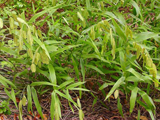Native Plants

Q. Who is Mr. Smarty Plants?
A: There are those who suspect Wildflower Center volunteers are the culpable and capable culprits. Yet, others think staff members play some, albeit small, role. You can torture us with your plant questions, but we will never reveal the Green Guru's secret identity.
Did you know you can access the Native Plant Information Network with your web-enabled smartphone?
Ask Mr. Smarty Plants is a free service provided by the staff and volunteers at the Lady Bird Johnson Wildflower Center.

rate this answer
Monday - June 18, 2012
From: Leander, TX
Region: Southwest
Topic: Xeriscapes, Drought Tolerant, Groundcovers, Shade Tolerant, Grasses or Grass-like, Herbs/Forbs
Title: Ground cover under live oaks
Answered by: Guy Thompson
QUESTION:
I have some areas under Live Oak trees (maybe 200 sq. ft.)that remain bare, in spite of trying Habiturf. Soil is dry, poor and shallow. Can you suggest a living ground cover that would not require major rework of the soil?ANSWER:
I have had the same experience as you, except my bare ground is under deciduous oaks, Quercus texana (Nuttall oak). I am experimenting with several native plants that will survive drought. I'm having pretty good luck with Calyptocarpus vialis (Straggler daisy), Carex planostachys (Cedar sedge), Salvia lyrata (Lyreleaf sage), and Paspalum setaceum (Thin paspalum). Some of the other sedges, such as Carex texensis (Texas sedge) and Carex amphibola (Creek sedge) might do well, although they might need slightly more water than Habiturf. These are all mowable at a height of about four inches. The first four species are common around suburban Central Texas, and I simply transplanted some from other spots in my yard. I also tried Tridens muticus (Slim tridens), but it seems too coarse for a lawn. If a taller grass will fit in, try Chasmanthium latifolium (Inland sea oats), which grows to about two feet in height and does very well in shade.
Images of some of my suggested species are shown below.
From the Image Gallery
More Herbs/Forbs Questions
When to Collect Rudbeckia triloba Seed?
September 13, 2014 - How soon after flowering may I cut Rudbeckia triloba flower heads to save seeds? Do cones need to be attached to the plant in or out of the ground to continue to mature?
view the full question and answer
Native perennials for Ft. Worth TX
March 17, 2013 - Mr. Smarty Pants,
I have two large planters around the back side of my saltwater pool where there is no decking. (sloped landscape) 8'long x 3' wide. I need low growing perennial plants that will ...
view the full question and answer
Iris brevicaulis in Southwest Michigan
April 22, 2007 - We live in Kalamazoo, MI (Southwest Michigan Zone 6) and discovered last year that we have an iris brevicaulis (we think) growing (and very pretty) on our property. It has the "zig zag" stem. It see...
view the full question and answer
Blue plants or flowers in Baltimore, MD
July 27, 2007 - I have a taxi company in the city called Bluecab. The headquarters is in an industrial area and the soil is tough and well, industrial. There will be no watering or maintenance done. Looks like a car ...
view the full question and answer
Plants to grow under a black walnut tree in PA
July 03, 2011 - I want to plant some shrubs and flowers in an area with southern exposure that is dry, sunny, and within the drip line of, and partially under a large black walnut tree. I had been told that native pl...
view the full question and answer
| Support the Wildflower Center by Donating Online or Becoming a Member today. |

